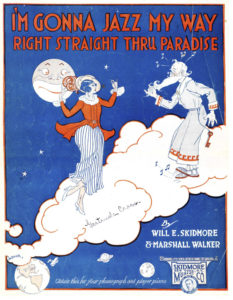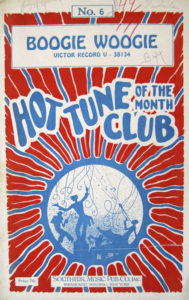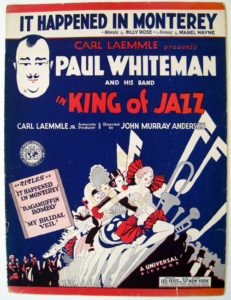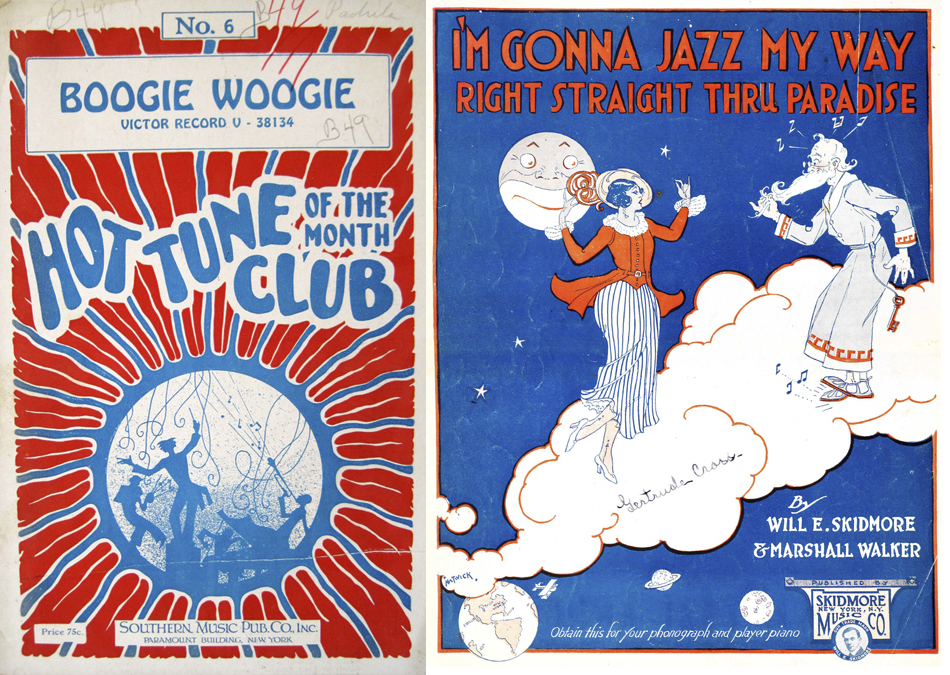April as Jazz Appreciation Month (JAM) was created to be an annual event that would pay tribute to jazz as both a living and as a historic music. Schools, organizations, and government institutions celebrate JAM with events ranging from free concerts to educational programs. During the 19th century, more people played and owned pianos and other musical instruments at home, with family and friends singing along. “Live” entertainment dominated in the pre-television era. People heard music they like on the radio, from stage performances and the movies, and could perform it at home, in school or on other occasions. Sheet music for classical and popular music, jazz, church, and more could be bought wherever records were sold. The Cooper Hewitt Library has been collecting sheet music primarily for exhibition and website content associated with Cooper Hewitt, Smithsonian Design Museum’s exhibition The Jazz Age: American Style in the 1920s.

I’m gonna jazz my way: right straight thru paradise. Will E. Skidmore; Marshall Walker, (Composer)
New York: Skidmore Music Co., 1919. Myron “Grim” Natwick, illustrator. (uncat)
I’m gonna Jazz my way… words and music by Will E. Skidmore and Marshall Walker. New York, NY, 1919. This is one among many of their successful musical collaborations during the 1920s. The music was composed by Marshall Walker, who wrote songs for the Ziegfeld Follies of 1919. Myron “Grim” Natwick a prolific graphic artist and designer, illustrated this cover, with many other sheet music designs to his credit.

Sheet music cover. Boogie Woogie. Arranged by Brewster-Raph. By King Oliver and David Nelson. Southern Music Pub. Co., Inc. Paramount Bulding, New York City, New York. 1930. (uncat)
Boogie woogie is a jazz style that consisted of piano improvisations. It became popular in Chicago during the 1920s, but was developed in African American communities in the 1870s. The style is an outgrowth of the blues-placed emphasis on rhythm rather than melody. This tune, Boogie Woogie, was written by Joseph Nathan Oliver (1881 –1938), better known as King Oliver, an American jazz cornet player and bandleader. He was a pioneer in the use of mutes in jazz and was the mentor and teacher of Louis Armstrong. His influence was strong. Armstrong claimed, “if it had not been for Joe Oliver, Jazz would not be what it is today.” The sheet music cover art has the popular silhouetted forms of musicians playing wildly, the colors and design forecasting a hint of the graphic arts of the pyschedelic 1960s.

Sheet music cover. Vocal score for movie “It happened in Monterey”. Words by Billy Rose. Music by Mabel Wayne. “Paul Whiteman and his band. “King of Jazz: Leo Feist Inc. New York, NY. 1930.
Paul Whiteman (1890 –1967), with a more traditional, classical musical background, heard a jazz band that changed his life forever. “It screeched, it bellowed at me from a trick platform in the middle of a smoke-hazed beer-fumed room. And it hit me hard. Raucous? Yes. Crude-undoubtedly. Unmusical-sure as you live. But rhythmic, catching as the smallpox and spirit lifting.” Never quite getting the style of true jazz, Whiteman offered popular music in attractive arrangements that borrowed instrumental techniques and harmonic and rhythmic elements from jazz, sometimes referred to as “symphonic jazz.” He and his orchestra went on to produce a million selling hit recordings, making him known by the public and press as “the King of Jazz.”
Jazz Appreciation Month is a music festival held every April in the United States, in honor of jazz as an early American art form. JAM was created in 2001 by John Edward Hasse, PhD, curator of the Smithsonian’s National Museum of American History with initial funding provided by the Ella Fitzgerald Charitable Foundation. Many Jazz greats are buried at Woodlawn Cemetery in the Bronx, and they offer regularly scheduled tours of these gravesites. For this special April 2017 Jazz Appreciation Month, they’re offering a special lecture and musical event, The Second Line: Jazz Funerals at Woodlawn, with Juilliard Celebrates Jazz.
Elizabeth Broman is a Reference Librarian at the Cooper Hewitt, Smithsonian Design Library.
